Have you found black mold on your concrete basements walls? Or on the concrete pavement in front of your house? Removing and cleaning a concrete surface is something you should take serious. Mold is a dreaded home invader, capable of causing severe health problems and destroying property. With all of the horror stories out there about black mold it’s no surprise it’s one of the worst discoveries for a homeowner.
Because black mold loves damp or wet areas, like underneath a sink, it’s no surprise it can flourish on concrete that is left wet. There are ways to remove black mold from concrete, although it requires protective gear and some elbow grease. If you want to remove black mould or any other type of mildew from your concrete you’ll need to do the job correctly the first time and prevent it from returning.
Table of Contents
Read the Frequently Asked Questions (
FAQ) for dealing with black mold on concrete.
Is Black Mold on Concrete Dangerous?
Yes, mold on your concrete surfaces can be dangerous. When exposed to large amounts of black mold, some people develop allergic reactions or asthma. People who are not allergic to mold can also experience irritation in their eyes, nose, skin, lungs, throat, or skin. People who are allergic to mold experience symptoms such as a running nose, prolonged sneezing, skin rashes, and red eyes when exposed to it. If one has a severe allergy to mold, he or she might experience severe reactions such as a shortness of breath, and this can be fatal. In some instances, people who have asthma and have developed mold allergy are likely to experience asthma attacks when exposed to mold.
-black-mold-on-concrete">What causes black mold on concrete?
Mold can grow on concrete for a number of reasons. Like other types of mold, black mold grows in areas where the conditions are right for them. Black mold will grow on surfaces with high moisture, which may be due to leaks in windows, roofs, pipes, and water tanks. The spores of black mold are transferred from one place to another through wind, animals, or water sources. If a wet concrete surface is exposed to black mold, the mold will thrive. Black mold reproduces quickly, and a small patch of it can multiply within a short time. This means that your concrete surface could be covered in black mold within a short time.
If the concrete is in a basement, the black mold may be caused by a leak from outside or faulty plumbing. Homes with high humidity also tend to have problems with mould growing on surfaces as well. Outdoor concrete, such as a patio, usually grows mildew when it doesn’t dry completely after it’s been soaked. This is typical of concrete that’s well shaded.
Can mold grow on concrete?
Mold can grow on concrete as long as there is moisture on it. Although concrete does not have sufficient food to support mold growth, it will thrive when there is adequate moisture. Dust and debris that accumulate on concrete surfaces become sources of food for mold, thus facilitating their growth. You can prevent mold growth on concrete surfaces by ensuring that they are clean and preventing moisture from accumulating on them.
ve-mold-from-concrete">How to remove mold from concrete?
The good news is removing black mold on concrete surfaces is fairly easy and straightforward. The main difficulty in removing the mold is the potential health hazards. Mold reproduces through spores released into the air, making it necessary to take precaution when cleaning the surface. Although some household molds will only irritate allergies, black mold can be very dangerous and cause severe health conditions. Removing black mold is just like any other form, it just requires extra care. It’s recommended that you start with the minimum protective gear, such as a mask and heavy-duty gloves. It also requires an N-95 respirator to protect you from spores and goggles. This gear is recommended by the EPA when cleaning mold and will protect you from any spores released into the air.
Does bleach kill mold on concrete?
Yes, bleach can kill black mold. Although mold grows in most surfaces with moisture, you can use bleach to kill it and fungi growing on hard impermeable surfaces. You can also use bleach to kill mold that grows on impervious surfaces like tiles and tubs but not on porous surfaces. This is because mold on permeable materials spread their roots deep. When you use bleach to kill them, you will only be wiping it from the surfaces. This means that it will re-emerge after a short while.
Does vinegar kill mold on concrete?
Yes, it does. You can use vinegar to kill mold because it is acidic. White vinegar is recommended for killing mold because scientific studies have shown that it can eliminate up to 82 % of mold spores. It is also advantageous to use vinegar because it is known to have disinfecting properties that will kill the viruses or bacteria on surfaces. You can use vinegar to do away with mold on hard nonporous and porous surfaces since it can seep into surfaces. When dealing with vinegar, be sure to use personal protective gear to prevent it from getting into contact with your body because it irritates. Use a liquid sprayer for a smoother application on the affected area and dry it before cleaning it.
on-outdoor-concrete">How to clean mold on outdoor concrete?
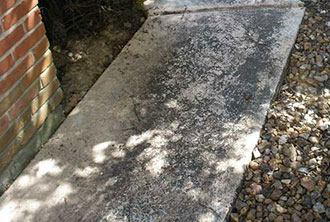 Cleaning and disinfecting mold-covered concrete is a fairly simple process and there are a few ways to do it. Cleaning outdoor concrete is the simplest because you can use a garden hose to finish the job. Create a cleaning solutions and pour it on the surface. Scrub and clean in a circular motion to clean like an expert. Spray down to finish the job. Voilà, all mold removed. Follow our detailed 4 steps removal guide below for the best result and lasting effect.
Cleaning and disinfecting mold-covered concrete is a fairly simple process and there are a few ways to do it. Cleaning outdoor concrete is the simplest because you can use a garden hose to finish the job. Create a cleaning solutions and pour it on the surface. Scrub and clean in a circular motion to clean like an expert. Spray down to finish the job. Voilà, all mold removed. Follow our detailed 4 steps removal guide below for the best result and lasting effect.
- Step 1: Create a cleaning solution
To begin you’ll need to create a cleaning solution that’s effective at black mold removal. Use a bucket to mix one-half cup of bleach diluted with one gallon on water. This amount of solution can treat an area about five square feet. If you need to clean a larger area simply double the solution.
- Step 2: Pour and wait
Simply pour the bleach solution onto the entire affected area and allow it to set for about fifteen minutes. This gives the bleach time to kill the black mould completely.
- Step 3</strong>: Tedious for the best
Now make a more concentrated solution with one cup of bleach with one gallon of water. Use a wire scrub brush to scrub the concrete in a circular motion. Although a bit tedious, this will make sure the mildew is completely removed from the surface of the concrete.
- Step 4: Spray down to finish the job
From here you simply use a hose to spray down the affected area, removing the cleaning solution from the surface.
How to remove mold from concrete patio?
The three steps you can follow when removing mold from your concrete patio are: clean the patio, scrub and clean with a mold-killing detergent. Rinse with hot water and let the wind dry your patio. Voilà, all mold removed. Follow our detailed 3 steps removal guide below for the best result and lasting effect.
- Step 1: Clean your patio
The first step is to clean your concrete patio. You can use a vacuum cleaner and a feather duster to clean your patio. The cleaning process will help you get rid of the visible mold.
- Step 2: Scrub
The second step is to scrub your patio to get rid of any traces of mold. You can use the ordinary home cleaning detergents with warm water to clean your patio. If there are stubborn stains, consider using a wire brush to clean them.
- Step 3: Use vinegar/bleach
Once you have scrubbed the surface, use a bleach solution or vinegar to spray your concrete patio. The mixing ratio of your bleach with water should be one cup of bleach to a gallon of warm water. When cleaning, make sure to wear personal protective gear to protect yourself from the effects of the vinegar or bleach.
![]()
ing="async" src="https://blackmoldcontrol.com/wp-content/uploads/black-mold-on-concrete-walls.jpg" alt="black mold on concrete walls" width="540" height="285" class="aligncenter size-full wp-image-1363" srcset="https://blackmoldcontrol.com/wp-content/uploads/black-mold-on-concrete-walls.jpg 540w, https://blackmoldcontrol.com/wp-content/uploads/black-mold-on-concrete-walls-300x158.jpg 300w" sizes="(max-width: 540px) 100vw, 540px" />
Black mold on concrete in basement
For black mold on concrete in a basement, start by ventilating the area well. Because you’ll be using bleach indoors, open a window and escape the fumes when possible. Create a cleaning solution that’s one part bleach to four parts water and apply it to the concrete. Allow this solution to sit for fifteen minutes before using a wire scrub brush to clean the mold off the surface. Make sure you leave the area while the bleach is soaking to prevent breathing in fumes. It’s important to wear protective gear during this process, including rubber gloves and a respirator. After you’ve scrubbed the area, soak up the cleaning solution and apply clean water. Scrub once more and remove all surface water. Allow the area to dry completely. If your basement area is relatively damp, use a fan to dry the floor quickly.
Mold on concrete floors
Moisture makes concrete a suitable breeding ground for fungi growth. With cement drenching moisture, black fungi spores find a perfect landing spot and start to procreate. The fungi destroy the floors aesthetic looks and may pose health hazards. Here’s how you remove fungi from floors.
How to remove m
old from concrete floors?
The best way to remove mold from concrete floors is to mix a mold-killing cleaning solution and scrub the floors. Rinse the surface with clean, hot water. Dry the floors with a towel or rag. Prior to the cleaning make sure to fix all pre-disposing factors. Voilà, all mold removed. Follow our detailed 3 steps removal guide below for the best result and lasting effect.
- Step 1: Fix all pre-disposing factors
You may want to figure out what exactly is encouraging the fungi growth on your floors. If it’s low relative humidity in your house, consider raising it through increasing temperature, improving ventilation or using a dehumidifier. Also, if there are leaks under the sinks, along pipes and on the roof, you might want to call in a plumber to fix the damage and prevent the moisture from getting to the concrete floors.
- Step 2: Mix solution and scrub
In a bucket, fill in some clean warm water, bleach, black fungi killing agent and a few squirts of non-ammonia detergent. Take a scrubbing brush, dip into the bucket and clean the molded concrete floor. Repeat the procedure in all the molded parts until you cover the entire area. Rinse the area with clean water and clean supplies to avoid reapplying the fungi spores back to the floor.
- Step 3</strong>: Dry the area
Once you’ve rinsed the surface with clean water, and the black fungi is clear, pat the surface with clean towels to remove excess moisture. You may consider applying a fungi repellent to seal the concrete.
Mold on concrete walls
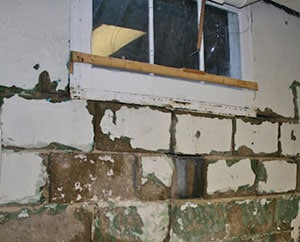 Black fungi on concrete walls mostly comes from moisture hitting and being absorbed into the wall. Before attempting to clean the walls, first resolve the moisture issue by redirecting downspouts and swamps from the wall. You could also try installing an interior footing drain to keep the water from the wall. Fix all water seepage from hose spots and taps. Also raising relative humidity in the house by improving ventilation would do the trick. You will then proceed to clean the molded concrete walls after fixing the moisture issue.
Black fungi on concrete walls mostly comes from moisture hitting and being absorbed into the wall. Before attempting to clean the walls, first resolve the moisture issue by redirecting downspouts and swamps from the wall. You could also try installing an interior footing drain to keep the water from the wall. Fix all water seepage from hose spots and taps. Also raising relative humidity in the house by improving ventilation would do the trick. You will then proceed to clean the molded concrete walls after fixing the moisture issue.
How to remove mold from concrete walls?
The best way to remove mold from concrete walls is to clean and scrub the surface with mold-killing detergent, rinse the walls with clean water. Dry inside walls with a towel or rag, let a cool breeze dry outside walls. Voilà, all mold removed. Follow our detailed 4 steps removal guide below for the best result and lasting effect.
- Step 1: Select a cleaning agent
You may use diluted bleach, fungi-killing detergent, and a regular cleaner all mixed into water. It shouldn’t be too abrasive to avoid causing damage.
- Step 2: Apply the solution
Use a mild-abrasive brush to scrub the affected area until all the visible black mold is clear. If you are using a fungi-killing detergent, you may consider applying to the molded areas directly and follow with a good scrub.
- Step 3: Rinse
Once the fungi are off, empty the bucket with fungi residue and refill with clean water. You may also use a hot water pressure washer for easier rinsing. The regular hose may also help with the rinsing. Ensure that all the fungi residue falls off the wall.
- Step 4</strong>: Dry the walls
Dry the wall with a clean towel and let it rest. Sweep all the fungi residue to prevent re-growth.
Best concrete mold cleaner
Complete Mold Killer & Remover DIY Bundle – Kill, Clean and Prevent Fungi & Mildew (1-32oz RMR 86, 1-32oz RMR-141 RTU & 2 Trigger sprayers) – [see this product on Amazon] This product comes a two in one package. The first product, cleaner RMR-141 RTU is a certified fungicide that kills and prevents re-growth of black fungi. The second product, cleaner RMR-86 black fungi stain remover clears all fungi stains. When paired together, the two products will wash all your fungi worries away.
How to prevent mold on concrete?
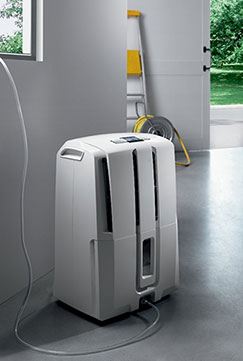 Preventing black mold from entering your home is fairly straightforward, although it requires staying on top of the situation. Because fungus loves to flourish on damp areas, make sure rooms with regular water exposure like the kitchen and bathroom are well-ventilated. Dehumidifiers are helpful is small rooms with high humidity levels. Always check for leaking pipes as well, which are a major cause of household mold. Preventing mold in the basement is a bit trickier. You’ll need to make sure ground water runs away from your home to prevent it from collecting near the basement. Check that sprinklers and downspouts aren’t depositing water near the basement walls or windows. Prevent condensation on basement water pipes by wrapping them. Use an exhaust fan in the bathrooms of your home after showering. Finally, keep the humidity in your basement below 60%. Running a dehumidifier downstairs may be your only option if you live in an area with high humidity.
Preventing black mold from entering your home is fairly straightforward, although it requires staying on top of the situation. Because fungus loves to flourish on damp areas, make sure rooms with regular water exposure like the kitchen and bathroom are well-ventilated. Dehumidifiers are helpful is small rooms with high humidity levels. Always check for leaking pipes as well, which are a major cause of household mold. Preventing mold in the basement is a bit trickier. You’ll need to make sure ground water runs away from your home to prevent it from collecting near the basement. Check that sprinklers and downspouts aren’t depositing water near the basement walls or windows. Prevent condensation on basement water pipes by wrapping them. Use an exhaust fan in the bathrooms of your home after showering. Finally, keep the humidity in your basement below 60%. Running a dehumidifier downstairs may be your only option if you live in an area with high humidity.
Tools and prote
ctive gear
Black mold removal requires a few household tools and some more advanced protective gear. You’ll need a bucket, bleach, disposable rags, rubber gloves, heavy-duty garbage bags to dispose of contaminated material, and a wire scrub brush. It’s also necessary to use good protective gear. For black mold, an N-95 respirator is the minimum advised. You’ll also need goggles to protect your eyes from spores in the air.
Warnings
Because there are health hazards when you remove black mold from concrete, make sure you always use the proper protective gear. Don’t allow it’s spores to contaminate other areas of your home. Isolating the affected area is important because mildew spreads through spores in the area. When cleaning, use caution with cleaning solutions. Always ventilate the area properly when using bleach as the fumes can overwhelm you. Never mix cleaning solutions because the result can be toxic. Mixing bleach and ammonia is especially dangerous as a poisonous gas is produced. You can also outsource the job to a black mold expert to do it for you.
Frequently Asked Questions
Welcome to our Frequently Asked Questions (FAQ) section dedicated to addressing the persistent issue of black mold on concrete surfaces. Whether you’ve noticed this unsightly problem in your basement, garage, or outdoor spaces, we understand the concerns it raises about potential health risks and structural integrity. In this comprehensive FAQ, we aim to provide you with valuable insights, expert guidance, and practical solutions to effectively combat black mold on concrete. From understanding its causes and health implications to discovering the best cleaning methods and preventive measures, we’re here to empower you with the knowledge to tackle this common challenge head-on. Let’s explore the essential questions and find the answers you need to keep your concrete surfaces mold-free and maintain a safe and hygienic living environment.
row">
Question:
What causes black mold to grow on concrete surfaces?
Answer: Black mold on concrete thrives in damp and humid conditions, where moisture accumulates and organic matter is present. Common areas of growth include basements, garages, and outdoor surfaces exposed to moisture.
Question:
Is black mold on concrete harmful to health?
Answer: Yes, black mold on concrete can be harmful, especially for individuals with allergies, asthma, or compromised immune systems. Prolonged exposure to mold spores may lead to respiratory issues and other health concerns.
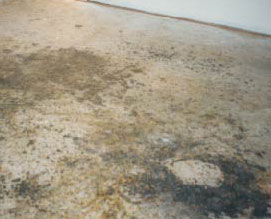
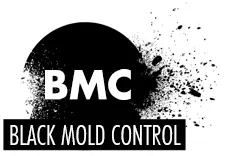
 Cleaning and disinfecting mold-covered concrete is a fairly simple process and there are a few ways to do it. Cleaning outdoor concrete is the simplest because you can use a garden hose to finish the job. Create a cleaning solutions and pour it on the surface. Scrub and clean in a circular motion to clean like an expert. Spray down to finish the job. Voilà, all mold removed. Follow our detailed 4 steps removal guide below for the best result and lasting effect.
Cleaning and disinfecting mold-covered concrete is a fairly simple process and there are a few ways to do it. Cleaning outdoor concrete is the simplest because you can use a garden hose to finish the job. Create a cleaning solutions and pour it on the surface. Scrub and clean in a circular motion to clean like an expert. Spray down to finish the job. Voilà, all mold removed. Follow our detailed 4 steps removal guide below for the best result and lasting effect.  Black fungi on concrete walls mostly comes from moisture hitting and being absorbed into the wall. Before attempting to clean the walls, first resolve the moisture issue by redirecting downspouts and swamps from the wall. You could also try installing an interior footing drain to keep the water from the wall. Fix all water seepage from hose spots and taps. Also raising relative humidity in the house by improving ventilation would do the trick. You will then proceed to clean the molded concrete walls after fixing the moisture issue.
Black fungi on concrete walls mostly comes from moisture hitting and being absorbed into the wall. Before attempting to clean the walls, first resolve the moisture issue by redirecting downspouts and swamps from the wall. You could also try installing an interior footing drain to keep the water from the wall. Fix all water seepage from hose spots and taps. Also raising relative humidity in the house by improving ventilation would do the trick. You will then proceed to clean the molded concrete walls after fixing the moisture issue. Preventing black mold from entering your home is fairly straightforward, although it requires staying on top of the situation. Because fungus loves to flourish on damp areas, make sure rooms with regular water exposure like the
Preventing black mold from entering your home is fairly straightforward, although it requires staying on top of the situation. Because fungus loves to flourish on damp areas, make sure rooms with regular water exposure like the